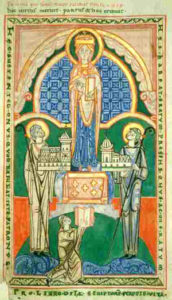A Shared Experience
The Cistercian charism is a shared experience of the Spirit that transforms the person and conforms them to Christ within a monastic community of brothers or sisters. The primitive documents of the Order of Citeaux, instead of defining the Cistercian Charism, narrate the process that led to the foundation of the New Monastery and provide a structure that would ensure fidelity to the intentions of the foundational community as well as the means to actualize the grace received as the Order developed. Hence, the Order of Citeaux was born and evolved through the continual contact with the Mystery of Christ in contemplation, liturgy, study, labor, and communal discernment to respond to the signs of the times according to the monastic vocation. From the beginning, our founders, St. Robert of Molesme, St. Alberic, and St. Stephen Harding, the founding abbots of Citeaux, and the larger community they represent, discerning with creative fidelity, created a new balance of the monastic values already expressed by the Rule of St. Benedict through the action of the Spirit in them and their contemporaries. In the foundational document of the Order, the Carta Caritatis, they clearly stated that their successors should understand and keep the interpretation of the Holy Rule as they understood and kept it. What were the key elements that shaped their interpretation? Understanding these principles will allow us to remain like them within this continuum between fidelity and newness, faithful to our call to contemplation and service to the Church of today.
the Order of Citeaux, instead of defining the Cistercian Charism, narrate the process that led to the foundation of the New Monastery and provide a structure that would ensure fidelity to the intentions of the foundational community as well as the means to actualize the grace received as the Order developed. Hence, the Order of Citeaux was born and evolved through the continual contact with the Mystery of Christ in contemplation, liturgy, study, labor, and communal discernment to respond to the signs of the times according to the monastic vocation. From the beginning, our founders, St. Robert of Molesme, St. Alberic, and St. Stephen Harding, the founding abbots of Citeaux, and the larger community they represent, discerning with creative fidelity, created a new balance of the monastic values already expressed by the Rule of St. Benedict through the action of the Spirit in them and their contemporaries. In the foundational document of the Order, the Carta Caritatis, they clearly stated that their successors should understand and keep the interpretation of the Holy Rule as they understood and kept it. What were the key elements that shaped their interpretation? Understanding these principles will allow us to remain like them within this continuum between fidelity and newness, faithful to our call to contemplation and service to the Church of today.
A New Community to Follow the Rule of St Benedict More Freely and Steadfastly
The common desire to follow the Rule of Saint Benedict in its integrity was the motto that mobilized a group of Benedictine monks of the abbey of Molesme to look beyond its boundaries and start a community that they simply called the New Monastery. They had no intention to break with the monastic tradition; however, they realized that if they were to respond more freely to their common desire in the Spirit, that is, to follow the Rule and fulfil their vows more fully and steadfastly, they needed to form a new community to support and encourage one another in this resolve.
Poor with the Poor Christ
A new fidelity to the Rule implied the stripping of concessions and mitigations that had been added to the monastic practices through the centuries. The Cistercian conversatio that emerged through this process was marked by austerity and simplicity, which affected all the elements of the life: from meals to buildings and liturgical practices. There was an original emphasis on manual labor, which was a particular reading of the role that St. Benedict had assigned to work in his Rule. Physical work was a sign and a means to the spiritual work of the complete surrender of the will, following Christ’s total surrender in obedience to the Father. The discipline and austerity of daily Cistercian life fostered a process of transformation, emptying the self (self-will) to open it to God and community (common will).
Silence and Solitude as an Atmosphere for Contemplation
 Christ was thus followed into the desert. The return to the theme of the eremus in the narrative of the primitive documents pointed out the singular importance of silence and solitude as the necessary atmosphere for continual prayer. The renewed understanding of work developed by the first Cistercians generated a space of economic freedom that allowed for a separation from the world. This form of independence provided the necessary silence and solitude for a life of profound contemplation.
Christ was thus followed into the desert. The return to the theme of the eremus in the narrative of the primitive documents pointed out the singular importance of silence and solitude as the necessary atmosphere for continual prayer. The renewed understanding of work developed by the first Cistercians generated a space of economic freedom that allowed for a separation from the world. This form of independence provided the necessary silence and solitude for a life of profound contemplation.
Serving the Church and Responding to the Needs of Our Contemporaries
However, the desire to return to the root virtues and practices of monasticism was not a call to neo-primitivism. The trimming of additions created a renewed freedom that allowed the newborn Order to resonate with the needs and desires of their contemporaries and to be at the service of the Church in unique ways. The personal and communal discernment of our first Fathers made the Order an effective response to the Spirit, hence its singular rapid expansion.
A new consciousness of the individual emerged during the twelfth century which was embraced by Christian humanism. The writings St. Bernards and his followers provided believers with a Christology, anthropology, and theology of grace that spread hope and fostered the development of the person in all its potential. These teachings included and expanded the invitation to self-knowledge and self-awareness of the desert Fathers and Mothers. While the Carta Caritatis stated that the goal of the structure of the Order was “only charity and the advantage of souls in things human and divine”, the abbot of Clairvaux and other Cistercian writers became effective spiritual mentors and mystagogues who presented and implemented a spiritual method of transformation within the monastery, which they envisioned as a school of charity.
The Schola Caritatis: Transformation, Discernment, Support, and Accountability
The Cistercian way is the way of love. Its goal is union with God and in him with one another through the Holy Spirit, who acts in the soul as charity or grace. Cistercian love is affective and effective: affective attachment to the humanity of Christ that effectively transforms the soul through personal prayer, lectio divina, the celebration of the liturgy, and the humility and obedience of mutual service.
One of the innovations of the Cistercian interpretation of the Rule of St. Benedict is that the monasteries of the Order did not receive children. The candidates to Cistercian life were adults who needed to enter a process of transformation that included the integration and purification of their previous experiences, skills, and talents. The first generation of Cistercians developed an original pedagogy to understand, foster, and accompany this process of conversion. They used the tools provided by the monastic tradition combined with the support of different forms of accompaniment to channel the power of affectus and thus ensure the steady good zeal indispensable for a life oriented toward nothing less than holiness.
Cistercian Christology and anthropology will fully develop a new sense of mutuality in the relationship with God and neighbor based on the teachings of the Gospel, “I do not call you servants any longer, because the servant does not know what the master is doing; but I have called you friends, because I have made known to you everything that I have heard from my Father” (John 15:15). This approach expressed the cenobitic aspect of Benedictine monasticism, incorporating the new humanism of the twelfth century and the needs of the members entering the New Monastery. They, who had experienced the camaraderie of those joined in battle, now engaged together in spiritual warfare as a community with a common goal and a common discipline.
From Self-Will to Common Will
 The Prologue of the Rule insisted on the need to give up self-will as a prerequisite to doing battle for Christ. Obedience, humility, silence, and the various forms of relationships within community life fostered this movement with the ultimate goal of preferring nothing whatever to Christ and walking together toward everlasting life (RB 72). The Cistercian reform developed this ideal in a particular way. As Cistercians, the call is not only to give up self-will but to enter into a space of mutuality, the support and accountability that leads to transformation and contemplation; what St. Aelred of Rievaulx described in this treatise on spiritual friendship. Saint Bernard explains the conversion process of the will to which monastics are called in his third Sermon on the Resurrection of the Lord. Understanding conversion as the search for a common will, a will that is common with God and the brothers or sisters in our communities, is the mature evolution of the communal experience and call narrated in the Exordium Parvum and the legislation of the Carta Caritatis.
The Prologue of the Rule insisted on the need to give up self-will as a prerequisite to doing battle for Christ. Obedience, humility, silence, and the various forms of relationships within community life fostered this movement with the ultimate goal of preferring nothing whatever to Christ and walking together toward everlasting life (RB 72). The Cistercian reform developed this ideal in a particular way. As Cistercians, the call is not only to give up self-will but to enter into a space of mutuality, the support and accountability that leads to transformation and contemplation; what St. Aelred of Rievaulx described in this treatise on spiritual friendship. Saint Bernard explains the conversion process of the will to which monastics are called in his third Sermon on the Resurrection of the Lord. Understanding conversion as the search for a common will, a will that is common with God and the brothers or sisters in our communities, is the mature evolution of the communal experience and call narrated in the Exordium Parvum and the legislation of the Carta Caritatis.
The first steps of the Order had been the fruit of shared experience and discernment; therefore, the Carta Caritatis, as the foundational document of the Order, provided the necessary means to create this shared space for transformation and contemplation, wanting to ensure that future generations of Cistercians would also participate in this experience. The means of communal discernment, support, and accountability described in the Carta are meant to address anything that could jeopardize the experience of union with God and between the brethren, including the Order’s capacity to be receptive and responsive to the signs of the times and the needs of the Church in each generation, within the framework of the monastic vocation.
The sons and daughters of Citeaux embraced with new zeal and a desire for authenticity the austerity, simplicity, silence, and solitude of the rich heritage of the desert and the Rule of Benedict to enter fully into the Mystery of Christ in contemplation. However, these practices that shaped the Cistercian conversatio were not only the expression and path of renunciation of self-will but an open path that, through the grace and progressive transformation of the soul by charity, led to common will: the openness and consent to a form of love that makes us one in Christ through the Spirit.


 Find us on Facebook
Find us on Facebook Follow us on Pinterest
Follow us on Pinterest